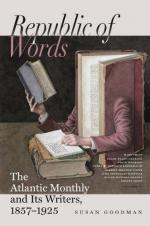“Really, she is a true woman!”
ABOUT WARWICK.
Between bright, new Leamington, the growth of the present century, and rusty Warwick, founded by King Cymbeline in the twilight ages, a thousand years before the mediaeval darkness, there are two roads, either of which may be measured by a sober-paced pedestrian in less than half an hour.
One of these avenues flows out of the midst of the smart parades and crescents of the former town,—along by hedges and beneath the shadow of great elms, past stuccoed Elizabethan villas and wayside ale-houses, and through a hamlet of modern aspect,—and runs straight into the principal thoroughfare of Warwick. The battlemented turrets of the castle, embowered half-way up in foliage, and the tall, slender tower of St. Mary’s Church, rising from among clustered roofs, have been visible almost from the commencement of the walk. Near the entrance of the town stands St. John’s School-House, a picturesque old edifice of stone, with four peaked gables in a row, alternately plain and ornamented, and wide, projecting windows, and a spacious and venerable porch, all overgrown with moss and ivy, and shut in from the world by a high stone fence, not less mossy than the gabled front. There is an iron gate, through the rusty open-work of which you see a grassy lawn, and almost expect to meet the shy, curious eyes of the little boys of past generations, peeping forth from their infantile antiquity into the strangeness of our present life. I find a peculiar charm in these long-established English schools, where the school-boy of to-day sits side by side, as it were, with his great-grandsire, on the same old benches, and often, I believe, thumbs a later, but unimproved edition of the same old grammar or arithmetic. The new-fangled notions of a Yankee school-committee would madden many a pedagogue, and shake down the roof of many a time-honored seat of learning, in the mother-country.
At this point, however, we will turn back, in order to follow up the other road from Leamington, which was the one that I loved best to take. It pursues a straight and level course, bordered by wide gravel-walks and overhung by the frequent elm, with here a cottage and there a villa, on one side a wooded plantation, and on the other a rich field of grass or grain, until, turning at right angles, it brings you to an arched bridge over the Avon. Its parapet is a balustrade carved out of freestone, into the soft substance of which a multitude of persons have engraved their names or initials, many of them now illegible, while others, more deeply cut, are illuminated with fresh green moss. These tokens indicate a famous spot; and casting our eyes along the smooth gleam and shadow of the quiet stream, through a vista of willows that droop on either side into the water, we behold the gray magnificence of Warwick Castle, uplifting itself among stately trees, and rearing its turrets high above their loftiest




